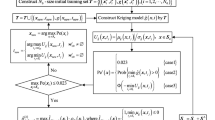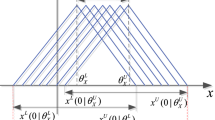Abstract
The time-dependent failure credibility (TDFC) can reasonably measure the safety level of the time-dependent structure under the fuzzy uncertainty, but the direct optimization algorithm to estimate the TDFC requires large computational cost and even results in locally optimal solutions. Therefore, an efficient method is proposed for estimating the TDFC by combining the fuzzy simulation and the single-loop Kriging model. In the proposed method, fuzzy inverse transformation theorem is firstly used to transform the estimation of the TDFC into a sample classification problem, in which the candidate sample pool generated by fuzzy simulation (FS) is classified into the failure group and the safety one. For improving the efficiency of the classification, a Kriging model is adaptively trained by an elaborate U-learning function in the candidate sample pool. After the candidate sample is divided into the failure group and the safety one by the convergent Kriging model, the TDFC can be estimated as a byproduct easily. The innovation of the proposed method includes two aspects: establishing the idea of the fuzzy simulation combined with the single-loop Kriging model to estimate TDFC efficiently and robustly, and designing an elaborate U-learning function to improve the efficiency of training the single-loop Kriging model. The presented examples validate the efficiency of the proposed method under the acceptable precision.












Similar content being viewed by others
References
Dubois D, Prade H (1987) The mean value of a fuzzy number. Fuzzy Sets Syst 24:279–300
Echard B, Gayton N, Lemaire M (2011) AK-MCS: an active learning reliability method combining Kriging and Monte Carlo simulation. Struct Saf 33(2):145–154
Elanayar VTS, Shin YC (1994) Radial basis function neural network for approximation and estimation of nonlinear stochastic dynamic systems. IEEE Trans Neural Netw 5(4):594–603
Elhewy AH, Mesbahi E, Pu Y (2006) Reliability analysis of structures using neural network method. Probabilistic Eng Mech 21(1):44–53
Elishakoff I, Ferracuti B (2006) Fuzzy sets based interpretation of the safety factor. Fuzzy Sets Syst 157(18):2495–2512
Fan CQ, Lu ZZ, Shi Y (2018) Safety life analysis under the required failure possibility constraint for structure involving fuzzy uncertainty. Struct Multidiscip Optim 58(1):287–303. https://doi.org/10.1007/s00158-017-1896-9
Feng KX, Lu ZZ, Pang C et al (2018) An efficient computational method of a moment-independent importance measure using quantile regression. Mech Syst Signal Process 109:235–246
Feng KX, Lu ZZ, Chao P (2019a) Safety life analysis under required failure credibility constraint for unsteady thermal structure with fuzzy input parameters. Struct Multidiscip Optim 59(1):43–59
Feng KX, Lu ZZ, Chao P, Yun WY (2019b) Time-dependent failure credibility analysis and its optimization based computational methods. Eng Struct 181:605–616
Guo SX, Lu ZZ, Feng LF (2002) Fuzzy arithmetic and solving of the static governing equations of fuzzy finite element method. Appl Math Mech 23(9):1054–1061
Hu Z, Du XP (2013) Time-dependent reliability analysis with joint upcrossing rates. Struct Multidiscip Optim 48:893–907
Hu Z, Mahadevan S (2016) A single-loop Kriging surrogate modeling for time-dependent reliability analysis. J Mech Des 138(6):061406 1-10
Hurtado JE (2004) An examination of methods for approximating implicit limit state functions from the viewpoint of statistical learning theory. Struct Saf 26(3):271–293
Hwang YS, Bang SY (1997) An efficient method to construct a radial basis function neural network classifier. Neural Netw 10(8):1495
Jia BX, Lu ZZ (2018) Root finding method of failure credibility for fuzzy safety analysis. Struct Multidiscip Optim 58(5):1917–1934
Jones DR, Schonlau M, Welch WJ (1998) Efficient global optimization of expensive black-box functions. Kluwer Acad Publishers 13(4):455–492
Kaymaz I (2005) Application of Kriging method to structural reliability problems. Struct Saf 27(2):133–151
Kaymaz R, McMahon CA (2005) A response surface method based on weighted regression for structural reliability analysis. Probabilistic Eng Mech 20:11–17
Ling CY, Lu ZZ, Feng KX (2019) An efficient method combining adaptive Kriging and fuzzy simulation for estimating failure credibility. Aerosp Sci Technol 92:620–634
Liu BD (2006) A survey of credibility theory. Fuzzy Optim Decis Making 5(4):387–408
Liu BD (2007) Uncertainty theory, 2th edition. Springer Publishing Company, New York
Liu YK, Liu BD (2002) Random fuzzy programming with chance measures defined by fuzzy integrals. Math Comput Model 36(4–5):509–524
Lophaven SN, Nielsen HB, Søndergaard J (2002) Aspects of the matlab toolbox DACE. Technical Report, Informatics and Mathematical Modeling, Technical University of Denmark, DTU
Matera F (1998) Radial basis function neural network. Subst Use Misuse 33(2):317–334
Möller B, Graf W, Beer M (2000) Fuzzy structural analysis using α-level optimization. Comput Mech 26(6):547–565
Nahmias S (1978) Fuzzy variables. Fuzzy Sets Syst 1:79–110
Ranjbar M, Marburg S (2013) Fast vibroacoustic optimization of mechanical structures using artificial neural networks. Int J Mech Eng Appl 1(3):64–68
Ranjbar M, Saffar MG (2016) A sensitivity analysis on application of artificial neural networks in structural acoustics. J Robot Mechatron Syst 1(2):23–26
Rao SS, Sawyer JP (1995) A fuzzy element approach for the analysis of imprecisely defined system. AIAA J 33(12):2364–2370
Sacks J, Schiller SB, Welch WJ (1989) Design for computer experiment. Technometrics 31(1):41–47
Sexsmith RG (1999) Probability-based safety analysis-value and drawbacks. Struct Saf 21(4):303–310
Wu XM, Bai YM, Wen FS (2011) Short-term wind power forecast based on the radial basis function neural network power system protection and control
Yun WY, Lu ZZ, Jiang X et al (2017) Maximum probable life time analysis under the required time-dependent failure probability constraint and its meta-model estimation. Struct Multidiscip Optim 55:1439–1451
Yun WY, Lu ZZ, Jiang X et al (2018) Borgonovo moment independent global sensitivity analysis by Gaussian radial basis function meta-model. Appl Math Model 54:378–392
Zadeh LA (1965) Fuzzy sets. Inf Control 8(3):338–353
Zadeh LA (1978) Fuzzy sets as a basis for a theory of possibility. Fuzzy Sets Syst 1:2–28
Funding
This work was supported by the National Natural Science Foundation of China (Grant Nos. NSFC 51775439 and NSFC 11902254) and National Science and Technology Major Project (Grant No. 2017-IV-0009-0046).
Author information
Authors and Affiliations
Corresponding author
Ethics declarations
Conflict of interest
The authors declare that they have no conflict of interest.
Replication of results
The MATLAB codes used to generate the results are available in the supplementary material.
Additional information
Responsible Editor: Byeng D Youn
We would like to declare that the work described was original research that has not been published previously, and not under consideration for publication elsewhere, in whole or in part.
Publisher’s Note
Springer Nature remains neutral with regard to jurisdictional claims in published maps and institutional affiliations.
Appendices
Appendix A Common membership functions
The following Table 9 lists several common membership functions which include the normal type, the logarithmic normal type and the Gaussian type, the triangular type, and the trapezoid type (Jia and Lu 2018).
Appendix B Kriging model
The Kriging model, as an unbiased estimation model with minimum variance, has the characteristics of combining global approximation and local random error. Its effectiveness does not depend on the existence of random errors, and it has a good fitting effect for the problem of high nonlinear degree and local response mutation. Therefore, the Kriging model can be used to approximate the global and local functions (Hurtado 2004). The Kriging model can be approximately expressed as follows,
where gK(X) is the unknown Kriging model, and p(X) = {p1(X), p2(X), …, pM(X)}T is the basis functions of the input variables X. β = {β1, β2, …, βM}T is the undetermined coefficients of the corresponding regression function, whose value can be estimated by the known response value; M represents the number of basis functions. z(X)is a Gaussian process with an expectation of 0 and a variance of \( {\sigma}_Z^2 \) created on the basis of global simulation. The covariance matrix of xi and xj can be expressed as,
where R(xi, xj)(i, j = 1, 2, .…, m) represents the correlation function of any two sample points. There are various function forms of R(xi, xj); Gaussian type (Lophaven et al. 2002) is commonly used, and its expression is shown as follows:
where θk(k = 1, 2, …, m) are the unknown correlation parameters. R is the correlation matrix, which is represented by the following formula:
Based on the theory of Kriging, the response value at the unknown point x can be obtained by the following formula:
where \( \hat{\boldsymbol{\beta}} \) is the estimated value of β, g is the column vector formed by the response value of the training samples, P = {p(x1), p(x2), .…, p(xm)}T is a m × M matrix, and r(x) is the correlation function vector between the training points and the prediction points, which can be expressed as
\( \overset{\frown }{\beta } \)and the variance estimate \( {\sigma}_Z^2 \) can be obtained by the following formula:
Relevant parameters θ = [θ1, θ2, …, θm]T can be obtained by solving the maximum value of maximum likelihood estimation (MLE) (Jones et al. 1998), namely,
Kriging model composed of the values of θ obtained by solving the above equation is the proxy model with the best fitting accuracy. Therefore, for any unknown point x, gK(x) follows a Gaussian distribution, i.e., \( {g}_K\left(\boldsymbol{x}\right)\sim N\left({\mu}_K\left(\boldsymbol{x}\right),{\sigma}_K^2\left(\boldsymbol{x}\right)\right) \), where the mean and variance are calculated as follows:
where the calculation of μK(x) and \( {\sigma}_K^2(x) \) can be realized by the DACE MATLAB toolbox.
Appendix C Radial basis function neural network
Artificial Neural Networks (ANN) is a mathematical model of algorithm that imitates the behavioral characteristics of animal neural networks and performs distributed parallel information processing (Elhewy et al. 2006). Radial basis function neural network (Matera 1998) is an efficient feed-forward neural network, which has the best approximation performance and global optimal characteristics, and has a simple structure and fast training speed. It is widely used in various fields such as pattern recognition and nonlinear function approximation.
RBF network realizes the non-linear transformation from input space to output space by linear combination of nonlinear basis functions. Radial basis neural networks generally use radial basis function (commonly Gaussian function) as activation function,
where xP is the training sample and ci is the selected center. By self-organizing the central learning method, the network output can be obtained as
The basis function of the RBF neural network is selected as a Gaussian function, so the variance σ can be obtained by the following formula:
where cmax is the maximum distance between the selected centers and h is the number of nodes in the hidden layer.
The connection weight of the neuron between the hidden layer and the output layer can be directly calculated by the least square method, and the calculation formula is as follows:
where N is the number of samples.
Rights and permissions
About this article
Cite this article
Jiang, X., Lu, Z. An efficient algorithm for time-dependent failure credibility by combining adaptive single-loop Kriging model with fuzzy simulation. Struct Multidisc Optim 62, 1025–1039 (2020). https://doi.org/10.1007/s00158-020-02609-0
Received:
Revised:
Accepted:
Published:
Issue Date:
DOI: https://doi.org/10.1007/s00158-020-02609-0




